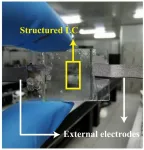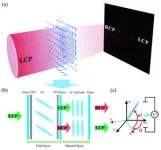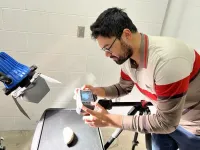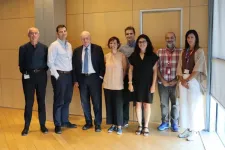(Press-News.org) WASHINGTON — Researchers have developed a new type of bifocal lens that offers a simple way to achieve two foci (or spots) with intensities that can be adjusted by applying external voltage. The lenses, which use two layers of liquid crystal structures, could be useful for various applications such as optical interconnections, biological imaging, augmented/virtual reality devices and optical computing.
“Most liquid-crystal-based devices are made from single-layer structures, but this limits light field modulation to a confined area,” said research team leader Fan Fan from Hunan University in China. “We used bilayer structures composed of a liquid crystal cell and a liquid crystal polymer to realize more complex and functional modulation of incident light.”
In the Optica Publishing Group journal Optics Letters, the researchers show that the new bifocal lenses can be used for polarization imaging, which is often used to enhance image contrast, and for edge imaging, which highlights the outlines of objects, making it easier to see fine details or spot certain shapes.
“In virtual or augmented reality devices, bifocal lenses are commonly used to adjust the distance of the image display to overcome vergence-accommodation conflict, which can cause visual discomfort and eye strain,” said Fan. “We believe that the light control mechanism we created using the multilayer structure could also be used to design other optical devices, including holographic devices and beam generators, or for optical image processing.”
Inspiration for a new design
The design for the bilayer bifocal lens was inspired by the rapid development of multi-functional holographic devices. “Researchers have devised many methods to improve the information capacity of holographic devices, including holographic devices based on multi-layer structures,” said Fan. “We thought this type of structure could be useful beyond the field of holographic displays, so we tried to expand its application scenarios.”
Although some bifocal lenses can create different focal points depending on the incident light’s polarization, the new bilayer bifocal lenses actively manipulate the polarization states of the output beams. This allows the bilayer lenses to split left-handed circularly polarized light into two focused light beams, one with left-handed and one with right-handed circular polarization. The liquid crystal cell layer also enables the bifocal lenses to rapidly change foci intensity in response to an external voltage. Previously developed bifocal lenses required mechanical rotation of the wave plate to accomplish this.
After confirming that the bifocal lens’s point spread function – a measure of the ability to focus light – agreed with theoretical calculations, the researchers incorporated the lens into imaging systems for polarization and edge imaging. For polarization imaging, the separation distance between the two foci is large (2 millimeters) while edge imaging uses a small (0.03 millimeters) separation distance with equal intensity for the two focal points. They showed that the bifocal lens performed well for both types of imaging.
Expanding to more applications
The researchers are now working on designing and manufacturing more multifunctional devices based on the bilayer structures for use in other research applications. They note that making these optical components practical will require lowering the cost in their mass production, incorporating the ability to adapt to different environments and designing fast and accurate layer-to-layer alignment technology.
“With this research, we aimed to illustrate the huge potential of bilayer structures for optical devices and the advantages of liquid crystal devices in electrical tunability,” said Fan. “We hope these unique features inspire scientists to develop even more advanced applications.”
Paper: Y. Zhou, X. Ye, Z. Li, D. Tang, F. Fan, “Bifocal lenses with adjustable intensities enabled by bilayer liquid crystal structures,” Opt. Lett., 49, 19 (2024).
DOI: https://doi.org/10.1364/OL.537415
About Optica Publishing Group
Optica Publishing Group is a division of the society, Optica, Advancing Optics and Photonics Worldwide. It publishes the largest collection of peer-reviewed and most-cited content in optics and photonics, including 18 prestigious journals, the society’s flagship member magazine, and papers and videos from more than 835 conferences. With over 400,000 journal articles, conference papers and videos to search, discover and access, our publications portfolio represents the full range of research in the field from around the globe.
About Optics Letters
Optics Letters has been publishing high-impact research in the field of photonics for over 45 years and offers rapid dissemination of new results in all areas of optical science with short, original, peer-reviewed communications. Optics Letters accepts papers that are noteworthy to a substantial part of the optics community. Published by Optica Publishing Group and led by Editor-in-Chief Miguel Alonso, Institut Fresnel, École Centrale de Marseille and Aix-Marseille Université, France, University of Rochester, USA. For more information, visit Optics Letters.
Media Contact
mediarelations@optica.org
END
Researchers harness liquid crystal structures to design simple, yet versatile bifocal lenses
Bilayer bifocal lenses with adjustable focal intensities could be useful for imaging, augmented reality and more
2024-09-30
ELSE PRESS RELEASES FROM THIS DATE:
Suicide attempts decreased after adding suicide care to primary care, study finds
2024-09-30
After suicide care was integrated into routine primary care visits, researchers saw a 25% decrease in the rate of suicide attempts in the following 90 days, a new Kaiser Permanente study finds.
The study, published in the Annals of Internal Medicine, is the first to show that suicide risk screening in primary care, followed by safety planning, improved suicide prevention efforts in a health care setting. The trial took place at Kaiser Permanente clinics in Washington state, using data from January 2015 to July 2018.
“Our findings are important because we know many people seek primary care prior to fatal and nonfatal suicide attempts,” ...
One in three Americans has a dysfunctional metabolism, but intermittent fasting could help
2024-09-30
LA JOLLA (Sept 30, 2024)—More than one-third of adults in the United States have metabolic syndrome, a cluster of conditions that significantly raise a person’s risk of heart disease, stroke, and type 2 diabetes. These conditions include high blood pressure, elevated blood sugar, excess abdominal fat, and abnormal cholesterol levels.
In a new clinical trial, researchers at the Salk Institute and University of California San Diego School of Medicine found that time-restricted eating—also known as intermittent fasting—could offer significant health benefits to adults with metabolic syndrome. Patients ...
Time-restricted eating associated with greater blood sugar control and fat loss than standard nutrition counseling
2024-09-30
Embargoed for release until 5:00 p.m. ET on Monday 30 September 2024
@Annalsofim
Below please find summaries of new articles that will be published in the next issue of Annals of Internal Medicine. The summaries are not intended to substitute for the full articles as a source of information. This information is under strict embargo and by taking it into possession, media representatives are committing to the terms of the embargo not only on their own behalf, but also on behalf of ...
New imaging technique brings us closer to simplified, low-cost agricultural quality assessment
2024-09-30
URBANA, Ill. – Hyperspectral imaging is a useful technique for analyzing the chemical composition of food and agricultural products. However, it is a costly and complicated procedure, which limits its practical application. A team of University of Illinois Urbana-Champaign researchers has developed a method to reconstruct hyperspectral images from standard RGB images using deep machine learning. This technique can greatly simplify the analytical process and potentially revolutionize product assessment in the agricultural industry.
“Hyperspectral ...
Purdue-led TOMI project receives $3.5M grant to turn a decade of data into new tools and strategies for tomato farmers
2024-09-30
Purdue-led TOMI project receives $3.5M grant to turn a decade of data into new tools and strategies for tomato farmers
WEST LAFAYETTE, Ind. — Indiana ranks third in the nation for tomato production. Lori Hoagland, a professor in Purdue University’s Department of Horticulture and Landscape Architecture, recently received a third grant from the U.S. Department of Agriculture’s National Institute of Food and Agriculture (USDA-NIFA) for the Tomato Organic Management and ...
Could a bout of COVID protect you from a severe case of flu?
2024-09-30
More than 200 viruses can infect and cause disease in humans; most of us will be infected by several over the course of a lifetime. Does an encounter with one virus influence how your immune system responds to a different one? If so, how? Does it weaken your defenses, boost them, or have some other impact altogether?
These are questions Rockefeller University scientists from the Laboratory of Virology and Infectious Disease,headed by Charles M. Rice, and Weill Cornell Medicine’s Laboratory of Epigenetics and Immunity, headed by Steven Z. Josefowicz, teamed up to answer in a new study published in the journal Immunity. ...
When detecting depression, the eyes have it
2024-09-30
Hoboken, N.J., September 30, 2024 – It has been estimated that nearly 300 million people, or about 4% of the global population, are afflicted by some form of depression. But detecting it can be difficult, particularly when those affected don’t (or won't) report negative feelings to friends, family or clinicians.
Now Stevens professor Sang Won Bae is working on several AI-powered smartphone applications and systems that could non-invasively warn us, and others, that we may be becoming depressed.
“Depression is a major challenge,” says Bae. “We want to help.”
"And since most people in the world today use smartphones daily, this could ...
NRG Oncology trial implies the addition of atezolizumab concurrently to standard of care does not improve survival in limited-stage small cell lung cancer
2024-09-30
The addition of the cancer immunotherapy drug atezolizumab to the standard of care concurrent chemoradiation (cCRT) did not improve overall survival for patients with limited-stage small cell lung cancer (LS-SCLC) in the second planned interim analysis of the NRG Oncology/Alliance NRG-LU005 clinical trial. These results were recently reported during the Plenary Session of the American Society for Radiation Oncology Annual Meeting in Washington, DC.
“While atezolizumab given concurrently with chemoradiation did not improve survival, we have still learned quite a bit from these findings. With the success of the ADRIATIC trial ...
NRG Oncology trial supports radiotherapy and cisplatin should remain the standard of care for p16+ oropharyngeal cancer
2024-09-30
The NRG Oncology NRG-HN005 phase II/III clinical trial did not meet the non-inferiority criteria to proceed to the phase III portion of the study. The phase II portion of the NRG-HN005 evaluated two experimental treatment arms against a control arm for patients with p16-positive (p16+, accepted as a surrogate for HPV+ status), locoregionally advanced oropharyngeal cancer. The interim futility results were recently reported during the Plenary Session of the American Society for Radiation Oncology Annual Meeting in Washington, DC.
“This ...
Progression of subclinical atherosclerosis predicts all-cause mortality risk
2024-09-30
A study carried out at Mount Sinaí Fuster Heart Hospital in New York in collaboration with the Centro Nacional de Investigaciones Cardiovasculares (CNIC) in Madrid provides important new information about atherosclerosis, a disease in which lipids (cholesterol) and other substances accumulate in plaques on the arterial wall, causing the vessels to harden and narrow, and increasing the risk of severe cardiovascular conditions.
The study, published in The Journal of the American College of Cardiology (JACC), was led by Dr. Valentín Fuster, Director of the Cardiovascular ...
LAST 30 PRESS RELEASES:
Tracing the quick synthesis of an industrially important catalyst
New software sheds light on cancer’s hidden genetic networks
UT Health San Antonio awarded $3 million in CPRIT grants to bolster cancer research and prevention efforts in South Texas
Third symposium spotlights global challenge of new contaminants in China’s fight against pollution
From straw to soil harmony: International team reveals how biochar supercharges carbon-smart farming
Myeloma: How AI is redrawing the map of cancer care
Manhattan E. Charurat, Ph.D., MHS invested as the Homer and Martha Gudelsky Distinguished Professor in Medicine at the University of Maryland School of Medicine
Insilico Medicine’s Pharma.AI Q4 Winter Launch Recap: Revolutionizing drug discovery with cutting-edge AI innovations, accelerating the path to pharmaceutical superintelligence
Nanoplastics have diet-dependent impacts on digestive system health
Brain neuron death occurs throughout life and increases with age, a natural human protein drug may halt neuron death in Alzheimer’s disease
SPIE and CLP announce the recipients of the 2025 Advanced Photonics Young Innovator Award
Lessons from the Caldor Fire’s Christmas Valley ‘Miracle’
Ant societies rose by trading individual protection for collective power
Research reveals how ancient viral DNA shapes early embryonic development
A molecular gatekeeper that controls protein synthesis
New ‘cloaking device’ concept to shield sensitive tech from magnetic fields
Researchers show impact of mountain building and climate change on alpine biodiversity
Study models the transition from Neanderthals to modern humans in Europe
University of Phoenix College of Doctoral Studies releases white paper on AI-driven skilling to reduce burnout and restore worker autonomy
AIs fail at the game of visual “telephone”
The levers for a sustainable food system
Potential changes in US homelessness by ending federal support for housing first programs
Vulnerability of large language models to prompt injection when providing medical advice
Researchers develop new system for high-energy-density, long-life, multi-electron transfer bromine-based flow batteries
Ending federal support for housing first programs could increase U.S. homelessness by 5% in one year, new JAMA study finds
New research uncovers molecular ‘safety switch’ shielding cancers from immune attack
Bacteria resisting viral infection can still sink carbon to ocean floor
Younger biological age may increase depression risk in older women during COVID-19
Bharat Innovates 2026 National Basecamp Showcases India’s Most Promising Deep-Tech Ventures
Here’s what determines whether your income level rises or falls
[Press-News.org] Researchers harness liquid crystal structures to design simple, yet versatile bifocal lensesBilayer bifocal lenses with adjustable focal intensities could be useful for imaging, augmented reality and more





